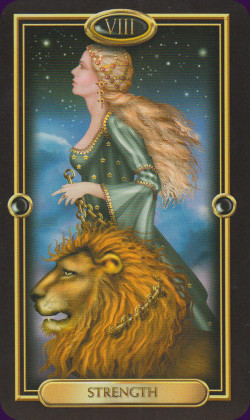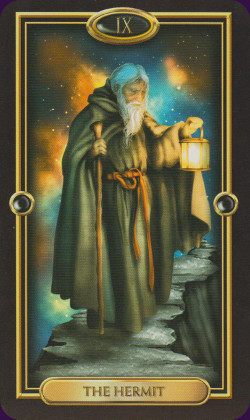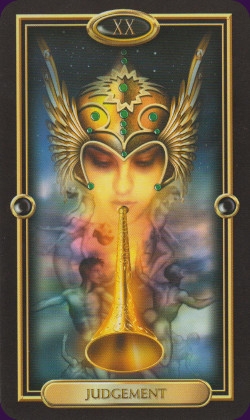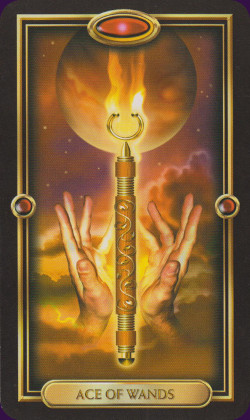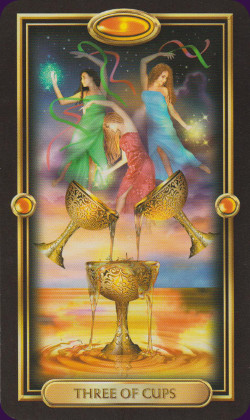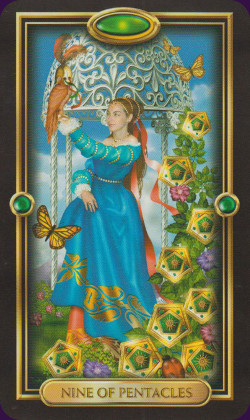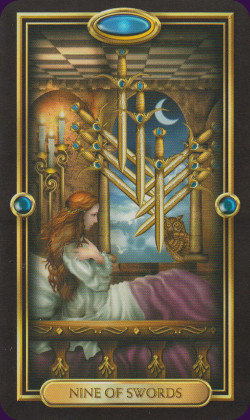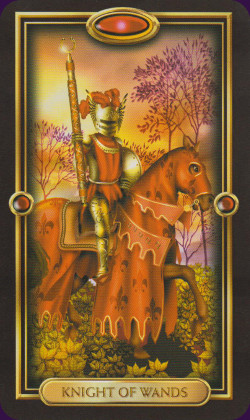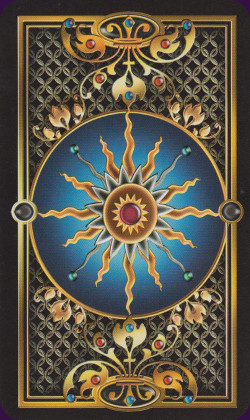Gilded Tarot Deck Review
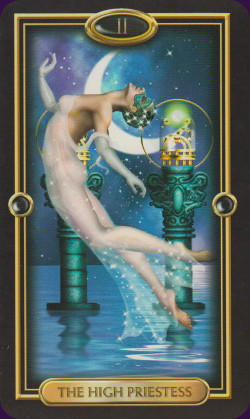
Creators: Ciro Marchetti
Publisher: Llewellyn 2004
The Gilded Tarot is a visually stunning Rider-Waite style tarot, the first from the talented Ciro Marchetti. The 78 cards feature real people, and have a mix of medieval, fantasy, cosmic and steampunk art, all illustrated in lush, vivid colour.
Retailers
See Price at Amazon.comSee Price at Amazon.co.uk
See Price at Amazon.ca
Gilded Tarot Review by Kate Hill
Review of the 2004 Llewellyn edition of the Gilded TarotWelcome to the Gilded Tarot world of fantasy, magic and enchantment. Its release as a mass-produced and widely available deck has been awaited with anticipation by those of us not able to afford one of the luxurious limited edition, hand-made copies direct from the artist, Ciro Marchetti.
There are few decks with artwork that Iíve found quite this attractive. Ciroís art is a sophisticated blend of digital paintings drawn by hand on a graphics tablet, and some pasted elements (mostly faces). The vibrancy and choice of the colours is fantastic: the backgrounds of blue skies, sunrises, night skies, twilight, stars and comets in many cards are so luminous they almost appear to glow, as do the strong, saturated blues, greens, purples and reds of the medieval-style costumes.
In symbolism, the Gilded Tarot is fundamentally Rider-Waite but it is not a clone or even a re-drawing of Pamela Colman-Smithís very familiar art. Rather than simply copying, Ciro has used its imagery as a jumping off point for his imagination and inspiration. The Gilded Tarot isnít one to use for its comparative historical symbolism or occult and esoteric depth, but the card images are unique and beautiful, feeling more like a beautiful fantasy or the inhabiting of a hyper-real dream-world than the Rider-Waite ever did.
The major arcana cards are traditionally named (bar the Hanged Man, who is here the Hanging Man). In most major cards the art has been stripped down to the main human figure, losing some of the familiar symbolism and detaching them somewhat from their environment. (The High Priestess, the Hanging Man, Temperance and the Fool Ė who looks interestingly but coincidentally like George W. Bush - literally float, weightlessly, in the air.)
The minor suits are Cups, Wands, Swords and Pentacles. The chosen suit symbols are fairly standard, though the Wands are unusual. Rather than magical or living wands, the Gilded Tarot has a unique baton that appears more like a fountain pen with a metal ring attached to one end. The deck has a few other mechanistic touches, especially noticeable in the Wheel, the Sun, Star and Moon, which is slightly at odds with the non-technological fantasy landscapes.
While the most of each card scene in the Gilded Tarot is a digital illustration, the human faces are not. Photographs rather than drawings of faces with the appropriate expression and angle have been used instead. I like this effect; my eye is drawn first to the human face in a card and I find it off-putting if a face is drawn clumsily or out of proportion (not an uncommon occurrence in many decks). The faces of the Gilded Tarotís medieval characters have a distinct reality of expression, which has been matched to the mood of the card. Overall, my favourite cards of the deck are the Hierophant (not usually one of my favourites, but the combination of the stained glass and robe colouring is stunning); Judgement, which seems to glow; the natural meadow scene with the moon in the Ace of Pentacles; the lighting, sky and colours of the Two of Wands and Page of Wands; the blue and purple sky colours in the Knight of Swords. (All of the Knights and the Kings are on my favourite list, actually, the composition of these cards is gorgeous.)
The Gilded Tarot cards are packaged in a front-opened cardboard box, along with a black organdie bag and a 168 page book. (I like these sets from Llewellyn, but there is usually a large amount of empty space in the box, and this means the packaging is almost always crushed in transit and arrives with torn corners and sunken panels.)
The book, 'The Gilded Tarot Companion' is a nice looking but extremely basic tarot manual. It does contain artist notes - a background on the deck, the inspiration and the motivations for its creation - but unfortunately nothing else written by Ciro. The rest of the book is a workbook written by Llewellynís Barbara Moore divided into Basics, Major Arcana, Minor Arcana, The Court Cards, and Spreads. The Basics section covers learning the cards, significators, reversals, divination, performing a reading, plus a number of exercises. The card meanings offer two paragraphs describing the image and its possible meaning, alongside plenty of space for notes, while the back of the book contains five common but useful tarot spreads. Together, the book and card set is suitable for beginners. More experienced readers will find little of novelty in the book or deeper insight into the images -- a separate cards-only edition could be a good idea.
I also would have liked to have seen this deck in a larger size with bigger pictures for easier viewing of the wealth of gorgeous detail and colour, but the Gilded Tarot is a still a deck to be admired. It is suitable for beginners; has wide appeal to querents with its attractive images and lack of nudity or frightening cards; and it is eminently worth collecting for the pleasure of the artwork.
Gilded Tarot Review by Brian Carles
In The Gilded Tarot Ciro Marchetti pays homage to the Rider-Waite deck, while adding his own personal touch. You can see Marchettiís art reflected in this tarot deck in that it features the signs of the zodiac, mechanical devices, and parts of nature; as are shown in his other works.
At first glance the Gilded Tarot may seem like any other Rider-Waite clone, but that is not necessarily the case. Structurally The Gilded Tarot is a normal tarot deck with the 22 cards of the major arcana having the usual names and numbering. The minor arcana include the usual suits of wands, cups, swords, and pentacles. However, one significant difference this deck has from normal tarot decks is that the background of the minor arcana isnít reflective of the element represented by the suit but rather scenes of nature with the occasional planet or moon and stars.
While this deck does incorporate symbolism from the Rider-Waite deck in the major arcana, Marchetti also incorporates some of his own ideas. This can be seen in the Fool card, which strays from the traditional format completely in that the fool has opened his bag of tricks and is employing what he knows as he is juggling the zodiac signs. Other differences are minor, such as the magician holding the symbols of the minor arcana with magic rather than merely looking over them. Another card that strikes interest is the Lovers, which strays from tradition in that the lovers are intertwined rather than just standing side by side. Strength does the same in that the woman has the lion as a pet rather than wrestling with it. The Devil is along the same lines in that it removes the chained man and woman, as well as changing the devil into a man in a mask. Here he may be making a comment as to that the devil being a creation of man? Marchetti takes a new approach to the Wheel Of Fortune in that the animals that are usually around the wheel are missing and the wheel has become a wheel of the zodiac.
The minor arcana includes the usual 56 cards, only slightly changed. The minor arcana includes the usual suits and court cards with one slight difference. The pages are female, or at least very feminine. This can also be seen in the Witches Tarot, and other decks that try to balance out the court cards. The minor arcana embraces Rider-Waite symbolism more than the major arcana, with a few differences. In the Eight Of Wands the wands are flying upward rather than downward, giving the card a more positive meaning than that of the same card in the Rider-Waite deck. In the Six of Swords, instead of the boy on a raft with the six swords itís a woman in a small boat. Has Marchetti changed the card to make it a symbol of the lady of the lake on her return to Avalon? Of course there are new illustrations as well such as the chest of pentacles in the Ten Of Pentacles, or the three women dancing in the sky over three cups in the Three Of Cups.
Marchetti being a card collector himself may have made this deck for tarot collectors. This deck may not be a good one for many tarot readers, for they prefer not to mix divining with technology. If you donít mind bending tradition though, this deck may be for you. This deck may also be good for those who like the symbolism of the Rider-Waite deck, or those interested in Rider-Waite clones. Those who are into astrology, technology, and nature would like this deck, as well as those that enjoy Marchettiís artwork.
This deck is a tribute to the Rider-Waite tarot deck
and it shows that. This deck is a mix of astrology,
technology and nature with Rider-Waite symbolism. Marchetti
adapts Rider-Waite to fit his own beliefs in this deck
and did a good job at it seeing that this was his
first tarot deck. Some of the cards change only slightly
from the Rider-Waite deck, and others go far from
tradition. This deck has great art work
and comes with a 150 page companion book by Barbara
Moore. Should it be so taboo to mix technology with
divination?
Gilded Tarot Review by Bonnie Cehovet
The Gilded Tarot is a Rider-Waite based deck, with updated imagery that students of today can easily connect with. It is a wonderful representation of the work done by graphic designer Ciro Marchetti - bright with color, and a wonderful use of the imagination.
Some of the imagery and symbolism is traditional, some of it has a mythical, faery tale quality to it. It is one of those decks that each time you use it, you see something new and different. One of the things that Marchetti talks about in his artist notes is the use of animals: be aware that they are not always there in their mythical form - sometimes they are there simply to observe the action within the card, and to draw your attention to said action. If you don't realize this, you could read more than was intended into some of these cards. For instance, the Owl in the Nine of Swords is there to make you ask questions, as well as (according to Marchetti) reinforce the idea that the scene is a night scene. The deer in the Two of Wands are there to point out that a decision is being made - in the Ten of Wands they appear to be observers. Death shows a Unicorn featured on a shield; the Ten of Cups features a cat; the Lovers shows leaping Dolphins; the Four of Wands shows rabbits; the Eight of Wands features sheep; the Four of Cups shows a squirrel and a mouse; the Six of Cups shows a cat peeking from the grasses; the Seven of Cups shows a Dove; the Eight of Cups shows a sleeping mole (to indicate blindness); a frog watches in the Six of Swords; in the Seven of Swords a cats watches curiously; in the Nine of Swords an Owl peeks in the window; in the Ten of Swords a deer looks on; in the Ace of Pentacles we have a weasel looking on;in the Seven of Pentacles we see sheep in the field; a mouse looks on, while a spider spins its web in the Eight of Pentacles; in the Ten of Pentacles a ferret peers into the wooden chest; in the Knight of Pentacles a rabbit peers through the greenery; a Peacock graces the Queen of Pentacles.
There is a Special Edition of this deck on Marchetti's site, at a hefty price, but the regular edition deck, through Llewellyn Worldwide, is at a much more affordable price, making this deck available on a much larger scale.
The presentation of the deck is along the lines of other recently published Llewellyn decks: the deck and book come in a box that opens from the top, with the deck and book inside, along with a white box in which to store the cards, and a black mesh bag (I know it is a cost consideration, but I truly wish that nice velvet bags were included with all decks). I did note something this time that I have not seen before - although it may have been there all along - and that is a set of instructions that go with the Little White Box (Little White Box - Little White Book: do we see a trend here!). Entitled "Caring for Your Cards", it includes such suggestions as embellishing the white box with protective or empowering symbols; wrapping the cards in a protective cloth or placing them in a bag; smudging the cards to clear their energy; and storing the cards with crystals or other stones. All very good suggestions - although some in the Tarot world may feel a bit uneasy about embellishing the white box with any kind of symbols.
Marchetti did a great deal of research before starting this deck, with one of the main reasons being that he did not want his work to be regarded in the "novelty" category. He has succeeded in creating a masterful deck along very traditional lines - a deck that could certainly serve as a beginners deck if a student so choose.
The artwork itself comes from the digital art venue - and is absolutely stunning! There is great attention to detail, and a very "otherworldly" feel to many of the cards. Marchetti notes that one of the recurring themes in his personal work is that of mechanical devices, devices that act as a bridge between the worlds of science and magic. We see this in cards such as the Wheel of Fortune, which has a mechanical base moving the Wheel; and in the Star, where we see a mechanical base upholding a globe of the world.
The cards are approximately 2 3/4" by 4 1/2", which make for an excellent size for small hands to work with. They are of good quality, glossy cardstock. The backs have a black background, with an inner 1/4" gold frame surrounding a jewel-toned inner setting, with the four corners marked off and a middle "flame" on a blue background. It would not be possible to tell whether the cards had been dealt upright or reversed.
The faces have a black background, with the same gold border acting as a frame (approximately 1/4" in from the edge of the card). (I believe that I get to say here that I prefer the decks that take the picture to the edge - I feel more like a participant than an observer.) Centered at the top of the deck the is a gold framed oval. With the Major Arcana, this oval is black, bearing the Roman Numeral for the card. With the Minor Arcana, the oval is colored, to represent each individual suit: Red for Wands, Orange for Cups, Blue for Swords, and Green for Pentacles. The Blue for Swords I can see - the color of communications, but I am at a loss for Orange for Cups! In the middle of the gold frame on each side of the card we see a blue-toned circle. At the bottom we have a gold plaque, with the card Title in black (for the Major Arcana), the number and suit in black (for the Minor Arcana), and the title and suit in black (for the court cards).
All of the cards in this deck are outstanding, but I have chosen a few to examine more closely that really drew me to them. The first card would be the literal "first" card of the deck - The Fool. Marchetti has depicted the Fool as a court jester, rather in what we might consider the "Carnivale" mode. This is also the first card in which we see one of the dominant themes in this deck - Astrology. The Fool is juggling the twelve signs of the zodiac, with the moon behind him. He dances with one foot in a gold hoop, and appears to have just stepped over a gold wand with colored ribbons on one end. I am definitely uneasy with this card - too much of the Trickster aspect here for me. From the book:
0 -The Fool
The Fool is at the beginning of his journey. All possibilities and seeming contradictions exist in this moment. The signs of the zodiac that he so carefully juggles indicate both the science of the heavens and the vastness of human imagination. These symbols represent all types of personality traits. Which one will he end up with? Will he make this important choice or will the choice be made for him by chance? Is he playing when he should be serious, or is his play filled with wisdom? Speaking of playing, is that gold hoop at his feet something he should be paying attention to, or is it a possible distraction? The Fool does not know, nor doe he much care. He lives in the moment, filled with wonder and curiosity, not worried about where the journey will end.
The Fool's message is one of unconventional choices. Take a leap of faith. Adopt a playful attitude in a serious situation. You are at a crossroads, and you have no way of knowing where each road will end. Pick one that strikes your fancy and set out with courage and a light heart. Prepare to meet all challenges with confidence.
Be aware of carelessness and folly. There is a difference between taking a risk and plowing headfirst into danger. reckless behavior can lead to a long path of unhappiness.
The High Priestess is shown between two pillars, with a quarter moon in the background. The pillars stand in water, and the female figure is shown wearing a transparent gown, arched back over the waters of the unconscious with nine glowing orbs (representing the nine planets) hovering around her head.
The Hanging Man (Hanged Man) is shown suspended by chains from what appears to be the Wheel of Fortune. To me, he appears to be flailing, as his hands are free and out at his sides - one arm hanging down, the other bent up at the elbow.
Death has to be one of the most stunning cards in this deck. In the middle of the card we see a blue/gray mask. A banner featuring a white pentacle (with a white flower superimposed on it) flies to the right hand side of the card, while under the mask is a shield with a Unicorn on it. The Ace of Cups shows a large gold Cup, with a blue eye centered over it, pouring down light. Arranged in an arc over the Cup are the six phases of the moon.
The Ten of Cups shows the typical family scene - but only the mother and daughter, and family cat, are shown sitting in front of the family home. Instead of a rainbow, ten cups are arched over the house. Marchetti mentions that this would be the view of the head of the household coming home to his wife and child. I find this approach a bit disconcerting - as if part of the family has been left out.
The Queen of Swords is my favorite Queen in this deck - and I generally do not like Swords in any deck! Her costume is medieval in nature, as are all of the court card costumes. This Queen stands, in her blue and purple gown, with her sword upraised - not in intimidation, but in readiness should she need to defend herself. Light glints off both the sword and her crown, to show the relationship between truth (the light of the Sun), her thoughts (the crown) and her actions (the sword).
The book that accompanies the deck is well written, with an introduction to the suits, the meaning of the numbers, the sequence of the Major Arcana, how to pose a question, how to choose a significator and such. My feeling here is that the information was very basic - perhaps too basic, and I did not see the need for imbedded references to other Llewellyn published books as references. This could have well been presented, if needed, at the end of the book.
Very basic (read incomplete) black and white scans accompany the presentation for the Major Arcana, and there are no scans for the Minor Arcana or the court cards. The text that is presented for each card to me is lacking in depth, and the description of the card itself very minimal. In a deck that is pushing the boundaries for imagery, a more in depth approach, such as the one that Rachel Pollack used for the Haindl Tarot, would have been more appropriate.
There are several useful spreads presented at the end of the book, including various versions of the Three Card spread (Past/Present/Future, Body/Mind/Spirit, and Choices); the Celtic Cross spread and a spread by Katie Vyvyan entitled the daily spread, which I found intriguing. (The positions in this spread are defined as Works (whatever you are accomplishing throughout the day, either at work or at home), Home (the people and activities surrounding the home), Unexpected (literally, the unexpected things that happen during the day), Your Role (your moods, actions and reactions), and Outcome (the outcome of the day, and the spiritual lesson(s) learned).
There are two extra cards with this deck: one shows the layout and position definitions for the Celtic Cross spread, the other shows the layout and position definitions for the daily spread. Nice inclusion - I like this!
The Gilded Tarot is a wonderful example of traditional structure with non-traditional imagery. It is a deck that anyone and everyone can use for any purpose that they wish. There is some nudity in this deck, so it may or may not be appropriate for use with children. IMHO, the "fact" of the nudity is overcome by the mythical/nagical setting in which it is presented. All levels of Tarot students/readers will find joy in working with the Gilded Tarot.
© Bonnie Cehovet
Gilded Tarot Review by Christopher Butler
Review of the Commercial Edition Published by Llewellyn
After a long wait, the commercial edition of the Gilded Tarot has now been published by Llewellyn. My copy arrived this morning and I thought it appropriate to review it, as a postscript to my original article on the limited edition.
As I stated in the earlier review, a commercial printing would not be able to match the quality and luminescence of the limited edition, mainly because of the more elaborate seven colour printing technique employed by the artist. This is certainly the case but I have to say that Llewellyn have done a marvellous job despite this. No, the colour is not as rich but yes, the eye soon adjusts and if you don't have anything to compare to you will be as thrilled opening this as I was the day I unpacked my limited edition. Why, because what you will hold in your hands is streets ahead of anything else on the market. If you enjoy reading with Rider based decks you will find no finer one than this.
If you are familiar with the Aeclectic Tarot Forum then you will know just what kind of excited admiration this deck has caused. Look at any thread. A good one can often have fifteen or sixteen pages of postings. Now look at a Gilded Tarot thread - very often thirty pages or more! Not bad considering that until the beginning of August 2004 there were only a maximum of 200 copies in print!
In presentation terms, Llewellyn have done the deck proud. The package contains the deck ( printed on excellent quality cardstock ), a wonderful book by Barbara Moore, a plain white box if you choose to use it and a very attractive black organdy tarot bag. The outer box is as beautifully designed as the deck.
The book contains detailed descriptions of the cards, accompanied by the elementary principles of tarot divination. There are blank journalling pages included in the Major Arcana section for your own observations.
This is not just a beautiful deck. It's both highly detailed and a well thought out reworking of the Rider format. I've no doubt it will become a classic and justifiably so. It should have a place in any serious collection.
Complete Details of Gilded Tarot
Creators: Ciro MarchettiPublisher: Llewellyn 2004
Deck Type: Tarot Deck
Cards: 78
Major Arcana: 22
Minor Arcana: 56
Deck Tradition: Rider-Waite-Smith
Minor Arcana Style: RWS-Based Scenes
Suits: Cups, Swords, Wands, Pentacles
Court Cards: Page, Knight, Queen, King
Major Titles: The Fool, The Magician, The High Priestess, The Empress, The Emperor, The Hierophant, The Lovers, The Chariot, Strength, The Hermit, Wheel of Fortune, Justice, The Hanging Man, Death, Temperance, The Devil, The Tower, The Star, The Moon, The Sun, Judgement, The World
The Fool is 0
Strength is 8
Justice is 11
Card Size: 2.75 x 4.63 in. = 6.99cm x 11.75cm
Card Language: English
Card Back: Reversible
Back Design: Colourful, jeweled, fantastical sun.
Companion Material: Companion book by Barbara Moore is packaged in the set.
Rating: 18/20 or
Similar Decks to Gilded Tarot
Theme: Beginner, SteampunkCategory: Available Tarot Decks, Computer Generated Tarot Decks, Popular Tarot Decks
Creator: Easy Tarot, Fin de Siecle Kipper, Gilded Reverie Lenormand, Gilded Tarot Royale, Legacy of the Divine Tarot, Oracle of Visions, Tarot of Dreams by Ciro Marchetti
< Previous Deck · Back to Top · Next Deck >
Home > Tarot Reviews > Gilded Tarot Review

